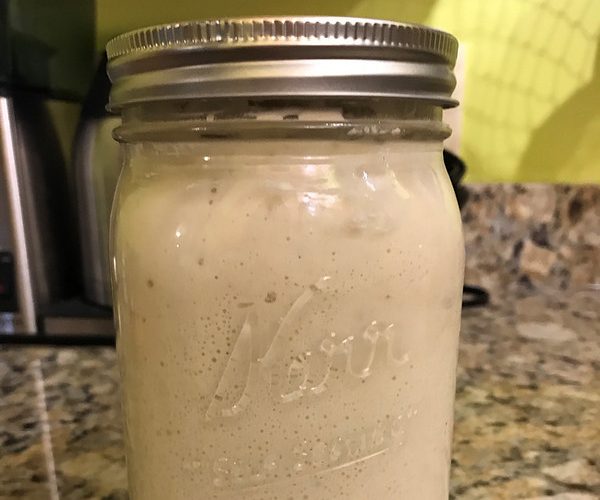Sourdough Starter Best Practices
Sourdough bread can safely be made at home, following best practices to cultivate a healthy and viable sourdough starter, or culture. Maintaining a sourdough starter involves managing an ecosystem of microscopic yeast and bacteria. The key to ensuring a healthy sourdough starter is controlling the factors which influence microbial survival and growth.

When making your own sourdough starter, keep the following best practices in mind:
- Use safe food-handling procedures. Start with clean kitchen equipment and surfaces, and use quality ingredients. Wash hands before handling ingredients and equipment, and at any time cleanliness is compromised. Limit airborne contaminants by keeping the starter loosely covered.
- Flour is a raw agricultural product. Flour itself is not a ready-to-eat food and should always be cooked before consuming. Flour could become contaminated at any point along the food chain, especially at home when handling. Do not taste raw sourdough starter before baking. Instead, a bubbly appearance, tangy smell, batter-like consistency, expansion, and records of preparation steps should be used to determine when your starter is ready. The fermentation process will acidify the starter, which helps prevent pathogen growth. The baking step will kill any bacteria present.
- Wild yeast is naturally on the flour and in the air. Yeast does not need to be intentionally captured from the air, nor does commercial yeast need to be added when making a sourdough starter. These wild yeasts are inactive, but under suitable conditions will become activated in the presence of water.
- Take care of your living starter. The fermenting microorganisms in sourdough starter need to be fed fresh flour and water regularly to survive and grow. Regular removal of some starter is an important step when feeding, to stabilize the volume of microorganisms and ensure nourishment for metabolic processes. Refrigeration can be used to prolong time between feedings in an active starter, but is not needed if feeding regularly. Sourdough starter can also be dried for long-term storage.
- Sourdough bread is made using a traditional fermentation process, which relies on bacteria and yeasts to produce a compositional change from the initial ingredients into a living leavening.
- A vibrant sourdough culture will limit growth of harmful microbes and baking will ensure a safe final product.
- Fermenting sourdough starter simply using flour and water takes practice and patience!
Monitor factors that influence microorganism growth:
- Time: Creating a starter or rehydrating a dried starter will take several days of regular feeding. It will bubble and rise, and develop a pleasantly sour smell when ready to use.
- Temperature: The fermenting microorganisms are more viable at temperatures that feel comfortable for you, a warm room temperature (around 70°F). Fermentation will slow at colder temperatures, and occur too rapidly or even stop when too hot for your own comfort.
- Moisture: Water combined with the flour will provide the environment needed to cultivate the wild yeast and bacteria. Keep starter loosely covered to discourage mold development.
- Acidity: Beneficial lactic acid bacteria (LAB) will produce lactic acid, which will increase the acidity, dropping the pH safely below 4.6. This rapid acidification of the sourdough starter will help limit growth of harmful microorganism, including mold.
- Nutrients: Regularly spaced feeding intervals are necessary. Removal of some starter with each new addition of flour and water assists with nutrient access for optimal microbial growth. Flour type will also have an impact on the microbial development and final product.
- Oxygen: Fermenting sourdough starters will produce carbon dioxide. The starter should be loosely covered in order to safely release the gas, but the culture does not require oxygen.
Troubleshooting:
- Contaminated starter should be discarded. Sourdough starter that shows any sign of mold (colored and/or fuzzy) should NOT be used, and the container should be thoroughly cleaned and rinsed before starting over. Sourdough starter may develop a liquid layer that smells of alcohol, and this is fine. The liquid is a by-product of the fermenting yeast and can either be poured off or stirred in. A sourdough starter that is kept in the refrigerator and not fed regularly may develop whitish clumps on the surface of the liquid layer that are safe yeasts, but not mold.
- High altitude adjustments. Make note that low humidity and low pressure at higher altitude has an effect on food preparation. Follow recipes either adjusted for altitude or make adjustments using High Altitude Food Preparation information from Colorado State University Extension.
- Considerations for bread starter variations:
- Amish Friendship Bread: Although rare, there have been incidents of foodborne illness associated with friendship-style bread, which differs from traditional sourdough by addition of milk and sugar, and thus provides an environment which could support growth of harmful microorganisms. To limit introductions of harmful bacteria in friendship bread starter, use pasteurized milk or cultured (soured) dairy and ferment in a refrigerator, not at room temperature.
- No-Knead Bread Using Commercial Yeast: Another popular style of artisan bread baking uses the ‘no-knead’ method, whereby commercial yeast provides the leavening, rather than the traditional fermentation process of wild yeast and bacterial cultures. Because these breads do not produce LAB growth or acid development, the dough should never exceed two hours at room temperature, and should be refrigerated for the remaining resting time.
Enjoy a safe, nourishing, and tasty balance of art and science:
A benefit from maintaining a sourdough ecosystem is a ready leavening that will yield bread and baked goods with high quality sensory characteristics and nutrient profiles. The fermentation process transforms the initial grain, developing more readily digestible protein content, decreasing starch content, improving some mineral and vitamin availability, and often increasing overall palatability.


